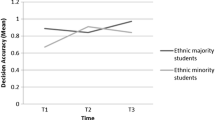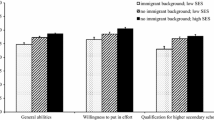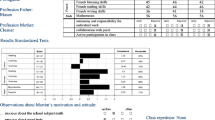Abstract
Research on school tracking has provided evidence that students with immigrant backgrounds are overrepresented in the lower school tracks. As teachers are the main decision makers when it comes to tracking, we investigated whether teachers’ tracking judgments are biased by the immigrant backgrounds of the students and how teachers’ tracking judgments are affected by inconsistencies in students’ academic profiles. Drawing on dual process models of judgment formation, we conducted two experimental studies to investigate teachers’ judgments. The results of both studies showed less favorable teacher judgments of students with immigrant backgrounds than of students without immigrant backgrounds. Students with inconsistent academic profiles were also judged less favorably than students with consistent profiles. Think aloud data indicated careful processing of all information both for students with immigrant backgrounds and students with inconsistent profiles. Results are discussed with regard to their underlying mechanisms as well as with regard to their implications for teacher training.
Similar content being viewed by others
References
Airasian, P. W. (1988). Symbolic validation: The case of state-mandated, high-stakes testing. Educational Evaluation and Policy Analysis, 10, 301–313. doi:10.2307/1164172.
Ansalone, G. (2001). Schooling, tracking, and inequality. Journal of Children and Poverty, 7, 33–47. doi:10.1080/10796120120038028.
Ansalone, G. (2003). Poverty, tracking, and the social construction of failure: International perspectives on tracking. Journal of Children and Poverty, 9, 3–20. doi:10.1080/1079612022000052698.
Ansalone, G., & Biafora, F. (2004). Elementary school teachers’ perceptions and attitudes to the educational structure of tracking. Education, 125, 249–260.
Arnold, K.-H., Bos, W., Richert, P., & Stubbe, T. C. (2007). Schullaufbahnpräferenzen am Ende der vierten Klassenstufe [Preferences in school career at the end of the fourth grade]. In W. Bos, S. Hornberg, K.-H. Arnold, G. Faust, L. Fried, E.-M. Lankes, K. Schwippert, et al. (Eds.), IGLU 2006. Lesekompetenzen von Grundschulkindern in Deutschland im internationalen Vergleich (pp. 271–297). Münster: Waxmann.
Baeriswyl, F., Wandeler, C., & Trautwein, U. (2011). “Auf einer anderen Schule oder bei einer anderen Lehrkraft hätte es für’s Gymnasium gereicht”: Eine Untersuchung zur Bedeutung von Schulen und Lehrkräften für die Übertrittsempfehlung [”Another school or another teacher would have recommended a higher tra. Zeitschrift für Pädagogische Psychologie, 25, 39–47. doi:10.1024/1010-0652/a000028.
Brewer, M. B. (1988). A dual process model of impression formation. In R. S. Wyer & T. K. Srull (Eds.), Advances in social cognition (pp. 1–36). Hillsdale, NJ: Erlbaum.
Brewer, M. B., & Lui, L. N. (1989). The primacy of age and sex in the structure of person categories. Social Cognition, 7, 262–274.
Burton, R., Reichert, M., Brunner, M., Keller, U., Böhm, B., & Martin, R. (2007). Migrationshintergrund und sozioökonomischer Hintergrund der Schülerinnen und Schüler [Immigrant background and socio-ecnomic status of students]. In MENPF and EMACS (Ed.), PISA 2006—Nationaler Bericht Luxemburg (pp. 32–45). Luxembourg, Luxembourg: MENPF and Université du Luxembourg.
Caro, D. H., Lenkeit, J., Lehmann, R., & Schwippert, K. (2009). The role of academic achievement growth in school track recommendations. Studies in Educational Evaluation, 35, 183–192. doi:10.1016/j.stueduc.2009.12.002.
Dee, T. S. (2005). A teacher like me: Does race, ethnicity, or gender matter? The American Economic Review, 95, 158–165. doi:10.1257/000282805774670446.
De Houwer, J. (2006). What are implicit measures and why are we using them? In R. W. Wiers & A. W. Stacy (Eds.), The handbook of implicit cognition and addiction (pp. 11–28). Thousand Oaks, CA: Sage Publisher.
Devine, P. G. (1989). Stereotypes and prejudice: Their automatic and controlled components. Journal of Personality and Social Psychology, 56, 5–18. doi:10.1037//0022-3514.56.1.5.
Ditton, H., Krüsken, J., & Schauenberg, M. (2005). Bildungsgleichheit - der Beitrag von Familie und Schule [Educational disparities and the contribution of family and school]. Zeitschrift für Erziehungswissenschaft, 8, 285–304. doi:10.1007/s11618-005-0138-x.
Dompnier, B., Pansu, P., & Bressoux, P. (2006). An integrative model of scholastic judgments: Pupils’ characteristics, class context, halo effect, and internal attributions. European Journal of Psychology of Education, 21, 119–133. doi:10.1007/BF03173572.
Dovidio, J. F., & Fazio, R. H. (1992). New technologies for the direct and indirect assessment of attitudes. In J. Tanur (Ed.), Questions about questions: Inquiries into the cognitive bases of surveys (pp. 204–237). New York: Russel Sage Foundation.
Erber, R., & Fiske, S. T. (1984). Outcome dependency and attention to inconsistent information. Journal of Personality and Social Psychology, 47, 709–726. doi:10.1037//0022-3514.47.4.709.
Fazio, R. H. (1990). Multiple processes by which attitudes guide behavior: The MODE model as an integrative framework. In M. P. Zanna (Ed.), Advances in Experimental Social Psychology (pp. 75–109). New York: Academic Press.
Fazio, R. H., Jackson, J. R., Dunton, B. C., & Williams, C. J. (1995). Variability in automatic activation as an unobtrusive measure of racial attitudes: A bona fide pipeline? Journal of Personality and Social Psychology, 69, 1013–1027. doi:10.1037/0022-3514.69.6.1013.
Fazio, R. H., & Towles-Schwen, T. (1999). The MODE model of attitude-behavior processes. In S. Chaiken & Y. Trope (Eds.), Dual process theories in social psychology (pp. 97–116). New York: Guilford Press.
Ferreira, M. B., Garcia-Marques, L., Sherman, S. J., & Sherman, J. W. (2006). Automatic and controlled components of judgment and decision making. Journal of Personality and Social Psychology, 91, 797–813. doi:10.1037/0022-3514.91.5.797.
Figlio, D. N., & Lucas, M. E. (2004). Do high grading standards affect student performance? Journal of Public Ecnomics, 88, 1815–1834. doi:10.1016/S0047-2727(03)00039-2.
Fiske, S. T., & Neuberg, S. L. (1990). A continuum of impression formation from category-based to individuating processes: Influences of information and motivation on attention and interpretation. In M. P. Zanna (Ed.), Advances in Experimental Social Psychology (Vol. 23, pp. 1–74). New York: Academic Press.
Fiske, S. T., Lin, M., & Neuberg, S. L. (1999). The continuum model. Ten years later. In S. Chaiken & Y. Trope (Eds.), Dual process theories in social psychology (pp. 231–254). New York: Guilford Press.
Fuchs, L. S., Deno, S. L., & Mirkin, P. K. (1984). The effects of frequent curriculum-based measurement and evaluation on pedagogy, student achievement, and student awareness of learning. American Educational Research Journal, 21, 449–460. doi:10.2307/1162454.
Gawronski, B., & Bodenhausen, G. V. (2006). Associative and propositional processes in evaluation: an integrative review of implicit and explicit attitude change. Psychological Bulletin, 132, 692–731. doi:10.1037/0033-2909.132.5.692.
Glock, S., & Krolak-Schwerdt, S. (2013). Does nationality matter? The impact of stereotypical expectations on student teachers’ judgments. Social Psychology of Education, 16, 111–127. doi:10.1007/s11218-012-9197-z.
Gröhlich, C., & Guill, K. (2009). How stable are reference group effects of secondary school track recommendations? Journal for Educational Research Online, 1, 154–171.
Haberlandt, K. (1994). Methods in reading research. In M. A. Gernsbacher (Ed.), Handbook of psycholinguistics (pp. 1–31). San Diego: Academic Press.
Hallinan, M. T. (1992). The organization of students for instruction in the middle school. Sociology of Education, 65, 114–127. doi:10.2307/2112678.
Hallinan, M. T. (1996). Track mobility in secondary school. Social Forces, 74, 983–1002. doi:10.2307/2580389.
Hastie, R. (1984). Causes and effects of causal attribution. Journal of Personality and Social Psychology, 46, 44–56. doi:10.1037//0022-3514.46.1.44.
Haycock, K. (2001). Closing the achievement gap. Educational Leadership, 58, 6–11.
Hemsley, G. D., & Marmurek, H. H. C. (1982). Person memory: The processing of consistent and inconsistent person information. Personality and Social Psychology Bulletin, 8, 433–438. doi:10.1177/0146167282083007.
Henz, U. (1997). Der nachgeholte Erwerb allgemeinbildender Schulabschlüsse [The catch up on high school diplomas]. Kölner Zeitschrift für Soziologie und Sozialpsychologie, 49, 223–241.
Hewstone, M., Hantzi, A., & Johnston, L. (1991). Social categorization and person memory: The pervasiveness of race as on organizing principle. European Journal of Social Psychology, 21, 517–528. doi:10.1002/ejsp.2420210606.
Hoffman, C., & Hurst, N. (1990). Gender stereotypes: Perception or rationalization. Journal of Personality and Social Psychology, 58, 197–208. doi:10.1037//0022-3514.58.2.197.
Jussim, L., & Harber, K. D. (2005). Teacher expectations and self-fulfilling prophecies: Knowns and unknowns, resolved and unresolved controversies. Personality and Social Psychology Review, 9, 131–155. doi:10.1207/s15327957pspr0902_3.
Kawakami, K., Dovidio, J. F., Moll, J., Hermsen, S., & Russin, A. (2000). Just say not (to stereotyping): Effects of training in the negation of stereotypic associations on stereotype activation. Journal of Personality and Social Psychology, 78, 871–888. doi:10.1037/0022-3514.78.5.871.
Klapproth, F., Glock, S., Böhmer, M., Krolak-Schwerdt, S., & Martin, R. (2012a). School placement decisions in Luxembourg: Do teachers meet the Education Ministry’s standards? The Literacy Information and Computer Education Journal, 1, 765–771.
Klapproth, F., Glock, S., Böhmer, M., Krolak-Schwerdt, S., & Martin, R. (2012b). Do social variables affect school placement decisions in Luxembourg? In C. A. Shoniregun & G. A. Akmayeva (Eds.), Ireland International Conference on Education—IICE 2012 proceedings (pp. 163–168). Basildon, UK: Infonomics Society.
KMK - Sekretariat der Ständigen Konferenz der Kultusminister der Länder in der Bundesrepublik Deutschland. (2010). Übergang von der Grundschule in Schulen des Sekundarbereichs I und Förderung, Beobachtung und Orientierung in den Jahrgangsstufen 5 und 6 (sog. Orientierungsstufe) [Transition from primary to secondary schools and advancement, observation, and orientation. Retrieved August 23, 2011, from http://www.kmk.org/fileadmin/veroeffentlichungen_beschluesse/2010/2010_10_18-Uebergang-Grundschule-S_eI1-Orientierungsstufe.pdf.
Krueger, J., Heckhausen, J., & Hundertmark, J. (1995). Perceiving middle-aged adults: Effects of stereotype-congruent and incongruent information. Journal of Gerontology: Psychological Sciences, 50B, P82–P93. doi:10.1093/geronb/50B.2.P82.
Leary, M. R., & Kowalski, R. M. (1990). Impression management: A literature review and two-component model. Psychological Bulletin, 107, 34–47. doi:10.1037//0033-2909.107.1.34.
Lee, J. (2002). Racial and ethnic achievement gap trends: Reversing the progress toward equity. Educational Researcher, 31, 3–12. doi:10.3102/0013189X031001003.
Lucas, S. R. (2001). Effectively maintained inequality: Education transitions, track mobility, and social background effects. American Journal of Sociology, 106, 1642–1690. doi:10.1086/321300.
Macrae, C. N., Milne, A. B., & Bodenhausen, G. V. (1994). Stereotypes as energy-saving devices: A peek inside the cognitive toolbox. Journal of Personality and Social Psychology, 66, 37–47. doi:10.1037//0022-3514.66.1.37.
Macrae, C. N., & Bodenhausen, G. V. (2000). Social cognition: Thinking categorically about others. Annual Review of Psychology, 51, 93–120. doi:10.1146/annurev.psych.51.1.93.
Maheswaran, D., & Chaiken, S. (1991). Promoting systematic processing in low-motivation settings: Effect of incongruent information on processing and judgment. Journal of Personality and Social Psychology, 61, 13–25. doi:10.1037//0022-3514.61.1.13.
Marsh, H. W. (1987). The big-fish-little-pond effect on academic self-concept. Journal of Educational Psychology, 79, 280–295. doi:10.1037//0022-0663.79.3.280.
Marston, D., Fuchs, L. S., & Deno, S. L. (1986). Measuring pupil progress: A comparison of standardized achievement tests and curriculum-related measures. Assessment for Effective Intervention, 11, 77–90. doi:10.1177/073724778601100203.
Martin, R., Houssemand, C., & Brunner, M. (2008). Quelles conclusion peut-on tirer de l’étude PISA en ce qui concerne le fonctionnement de l’école luxembourgiose? In C. D. R. Martin, C. Meyers, & M. Noesen (Eds.), La place de l’école dans la société luxembourgoise de demain (pp. 187–209). Bruxelles: De Boeck.
McCombs, R. C., & Gay, J. (1988). Effects of race, class, and IQ information on judgments of parochial grade school teachers. The Journal of Social Psychology, 128, 647–652. doi:10.1080/00224545.1988.9922918.
Neal, L. V., McCay, A. D., Webb-Johnson, G., & Bridget, S. T. (2003). The effects of African American movement styles on teachers’ perceptions and reactions. The Journal of Special Education, 37, 49–57. doi:10.1177/00224669030370010501.
Neumann, R., Hülsenbeck, K., & Seibt, B. (2004). Attitudes towards people with AIDS and avoidance behavior: Automatic and reflective bases of behavior. Journal of Experimental Social Psychology, 40, 543–550. doi:10.1016/j.jesp.2003.10.006.
Oakes, J. (1985). Keeping track: How schools structure inequality. New Haven: Yale University Press.
Oakes, J., & Guiton, G. (1995). Matchmaking: The Dynamics of high school tracking decisions. American Educational Research Journal, 32, 3–33. doi:10.3102/00028312032001003.
Parks, F. R., & Kennedy, J. H. (2007). The impact of race, physical attractiveness, and gender on education majors’ and teachers’ perceptions of student competence. Journal of Black Studies, 37, 936–943. doi:10.1177/0021934705285955.
Pigott, R. L., & Cowen, E. L. (2000). Teacher race, child race, racial congruence, and teacher ratings of children’s school adjustment. Journal of School Psychology, 38, 177–196. doi:10.1016/S0022-4405(99)00041-2.
Rosenthal, R., & Jacobson, L. (1968). Pygmalion in the classroom. New York: Holt, Rinehart, and Winston.
Rumberger, R. W. (1995). Dropping out of middle school: A multilevel analysis of students and schools. American Educational Research Journal, 32, 583–625. doi:10.2307/1163325.
Sanbonmatsu, D. M., & Fazio, R. H. (1990). The role of attitudes in memory-based decision making. Journal of Personality and Social Psychology, 59, 614–622. doi:10.1037//0022-3514.59.4.614.
Sbarra, D. A., & Pianta, R. C. (2001). Teacher ratings of behavior among African American and Caucasian children during the first two years of school. Psychology in the School, 38, 229–238. doi:10.1002/pits.1013.
Sherman, J. W., Lee, A. Y., Bessenoff, G. R., & Frost, L. A. (1998). Stereotype efficiency reconsidered: Encoding flexibility under cognitive load. Journal of Personality and Social Psychology, 75, 589–606. doi:10.1037//0022-3514.75.3.589.
Sherman, J. W., Conrey, F. R., & Groom, C. J. (2004). Encoding flexibility revisited: Stereotype-inconsistent information under cognitive load. Social Cognition, 22, 214–232. doi:10.1521/soco.22.2.214.35464.
Smith, A. E., Jussim, L., Eccles, J., VanNoy, M., Madon, S., & Palumbo, P. (1998). Self-fulfilling prophecies, perceptual biases, and accuracy at the individual and group levels. Journal of Experimental Social Psychology, 34, 530–561. doi:10.1006/jesp.1998.1363.
Soodak, L. C., & Podell, D. M. (1994). Teachers’ thinking about difficult-to-teach students. The Journal of Educational Research, 88, 44–51. doi:10.1080/00220671.1994.9944833.
Southworth, S., & Mickelson, R. A. (2007). The interactive effects of race, gender, and school composition on college track placement. Social Forces, 86, 497–523. doi:10.1093/sf/86.2.497.
Srull, T. K., & Wyer, R. S. (1989). Person memory and judgment. Psychological Review, 96, 58–83. doi:10.1037//0033-295X.96.1.58.
Swim, J., Borgida, E., Maruyama, G., & Myers, D. G. (1989). Joan McKay versus John McKay: Do gender stereotypes bias evaluations? Psychological Bulletin, 105, 409–429. doi:10.1037//0033-2909.105.3.409.
Tetlock, P. E., & Manstead, A. S. (1985). Impression management versus intrapsychic explanations in social psychology: A useful dichotomy? Psychological Review, 92, 59–77. doi:10.1037//0033-295X.92.1.59.
Thill, M. (2001). La nouvelle procedure de passage de l’enseignement primaire (public et privé) vers l’enseignement secondaire et secondaire technique: Resultats des conseil d’orientation et des procédures de recours [The new procedure for the transition from elementary to. Luxembourg: MENFP, SCRIPT.
Tournaki, N., & Podell, D. M. (2005). The impact of student characteristics and teacher efficacy on teachers’ predictions of student success. Teaching and Teacher Education, 21, 299–314. doi:10.1016/j.tate.2005.01.003.
van den Bergh, L., Denessen, E., Hornstra, L., Voeten, M., & Holland, R. W. (2010). The implicit prejudiced attitudes of teachers: Relations to teacher expectations and the ethnic achievement gap. American Educational Research Journal, 47, 497–527. doi:10.3102/0002831209353594.
Wiers, R. W., Van Woerden, N., Smulders, F. T. Y., & De Jong, P. J. (2002). Implicit and explicit alcohol-related cognitions in heavy and light drinkers. Journal of Abnormal Psychology, 111, 648–658. doi:10.1037//0021-843X.111.4.648.
Wölfel, O., & Heineck, G. (2012). Parental risk attitudes and children’s secondary school track choice. Economics of Education Review, 31, 727–743. doi:10.1016/j.econedurev.2012.05.004.
Zeidner, M., & Schleyer, E. J. (1998). The big-fish-little-pond effect for academic self-concept, test anxiety, and school grades in gifted child. Contemporary Educational Psychology, 24, 305–329. doi:10.1006/ceps.1998.0985.
Zima, B. T., Bussing, R., Freeman, S., Yang, X., Belin, T. R., & Forness, S. R. (2000). Behavior problems, academic skill delays and school failure among school-aged children in foster care: Their relationship to placement characteristics. Journal of Child and Family Studies, 9, 87–103. doi:10.1023/A:1009415800475.
Author information
Authors and Affiliations
Corresponding author
Additional information
We would like to thank the school inspectors for their help in recruiting the teachers.
The experiments reported in this paper were funded by Grant C08/LM/02 from the Fonds National de la Recherche Luxembourg (FNR).
Rights and permissions
About this article
Cite this article
Glock, S., Krolak-Schwerdt, S., Klapproth, F. et al. Beyond judgment bias: How students’ ethnicity and academic profile consistency influence teachers’ tracking judgments. Soc Psychol Educ 16, 555–573 (2013). https://doi.org/10.1007/s11218-013-9227-5
Received:
Accepted:
Published:
Issue Date:
DOI: https://doi.org/10.1007/s11218-013-9227-5




